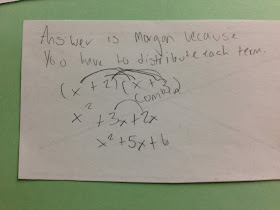The best compliment came from one of my students in the last period of the day who told me, "I think I am going to like this class - it's the first time all day I've done something besides listen to my teacher talk about a syllabus!"
We started off with this puzzle. I LOVE using these types of puzzles in my classroom - they are self checking and encourage problem solving and teamwork. I told students they were not allowed to write anything or use a calculator. They had to talk about their answers. I love all the different hearts- so much less intimidating than a variable for day 1. I enjoyed listening to students talk through these, make mistakes and problem solve to fix them. Plus, my students thought it was fun - win for everyone.
Since we had the team work mojo flowing, we went right into this Broken Circles Activity from Math=Love (She has free downloads for all group sizes, copies of the rules, and reflection questions).
My desks are grouped in threes, so I first had them complete it in groups of three, but I later discovered that the activity is way more fun in a bigger group. Each student has to make his/her own circle, but they have to do it in complete silence. I loved that the A pieces went right together to make a circle and that student was looking at the other two, thinking "What is wrong with you guys?" Try as Person B and C might, their pieces could not make a circle - I did have to clarify that I had not just cut the pieces poorly. When the students realized they had to work together, and A had to share his/her pieces, the circles fit together nicely. Sarah had some great reflection questions too and students did a great job identifying the ideas of teamwork and collaboration.
Finally, it was time for some colorful fun - this Back To School Pennant! There are directions for a glyph and students color it based on their favorite class, favorite season, number of siblings, and birth month. One student asked me, "What months are considered 'Fall'?" To be fair, the weather here in Florida doesn't change too much, but when I told him fall would be September, October, and November, he said, "Oh, football season! Well then that's definitely my favorite!" These pennants looks awesome. Not only was this activity fun for getting to know the students, it reinforced the idea of taking pride in your work. I told them to treat every assignment like it will be hung in a museum - take your time and do it right.

































